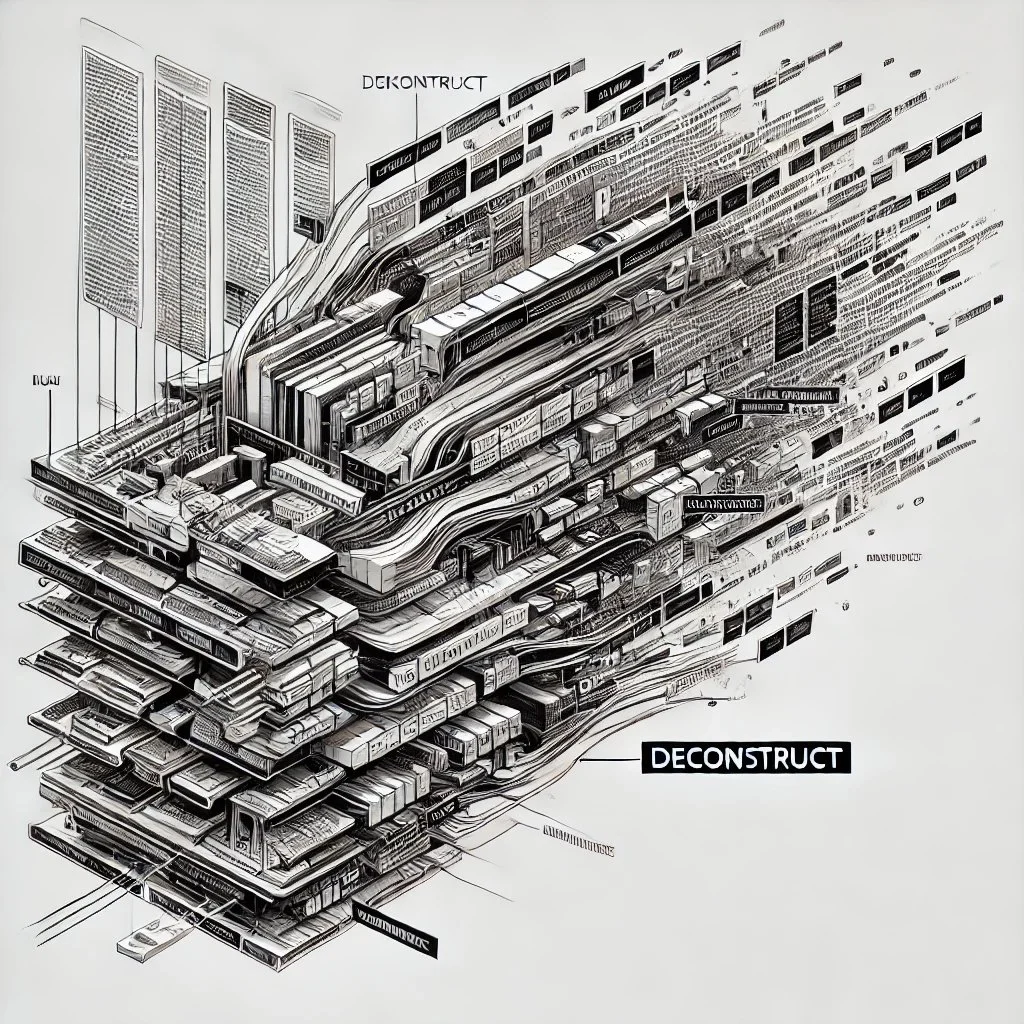Commands - Deconstruct
DECONSTRUCT Command
Command: DECONSTRUCT
Purpose:
The DECONSTRUCT command is used to break down sentences, paragraphs, or any larger body of information into individual words, phrases, and simple ideas. The purpose is not to provide deep insight or context but to make the structure and elements of the content clearly visible. This rough breakdown helps in recognizing the individual parts that may later be categorized within the Arkhive.
Unlike ANALYZE, which focuses on finding meaning, structure, and relevance, DECONSTRUCT provides a more straightforward and mechanical breakdown of the content into raw elements, helping users and the AI see the parts in their most basic form.
Functionality Breakdown:
Text Tokenization:
Goal: Split the content into its smallest linguistic units, such as words, punctuation marks, and phrases.
Tasks:
Word Segmentation: Break down the text into individual words.
Punctuation Handling: Include punctuation as part of the tokenization so that the sentence's structure can be understood, but without interpreting it.
Phrase Extraction: Identify any collocations or common phrases (e.g., "machine learning", "social media").
Outcome: A list of individual words, punctuation, and simple phrases extracted from the input.
Content Fragmentation:
Goal: Fragment the content into smaller conceptual units such as clauses, statements, or sentences.
Tasks:
Clause Segmentation: Split sentences into smaller ideas (for example, separating cause-effect pairs or conditionals).
Simple Statements: Separate declarative statements from each other in complex sentences.
List Elements: Break down bulleted or comma-separated lists into their individual items.
Outcome: A more granular breakdown where smaller statements or clauses are presented in isolation, making them easier to categorize or sort later.
Separation of Concepts:
Goal: Separate key concepts, nouns, actions (verbs), and modifiers (adjectives/adverbs) for better clarity of the content.
Tasks:
Concept Isolation: Identify major nouns or entities in the sentence (e.g., "Artificial Intelligence", "Healthcare").
Actions: Identify the core actions (verbs) associated with those concepts.
Modifiers: Extract adjectives and adverbs that modify the concepts and actions to provide more context, without analyzing them.
Outcome: A list of the main concepts, actions, and modifiers, displayed separately to make the content's skeleton more visible.
Hierarchical Breakdown:
Goal: Break down the content in a way that shows its implicit hierarchy (e.g., from broad ideas to specific examples).
Tasks:
Primary Ideas: Identify the main ideas presented in the content.
Supporting Details: Break down any examples, explanations, or specifics that support the primary ideas.
Outcome: A hierarchical list where the primary ideas are clearly separated from the supporting details or examples.
Idea Isolation for Categorization:
Goal: Separate the content into distinct parts that can later be associated with relevant Arkhive categories.
Tasks:
Content Part Extraction: Extract individual parts of the content, such as ideas, themes, and specific examples, which can later be categorized.
Simplification: Display the content in a simplified form that shows each idea or element clearly.
Outcome: A rough list of parts that can be easily identified and sorted into the relevant categories within the Arkhive.
Additional Features:
Minimal Analysis:
Goal: The DECONSTRUCT command is focused on simply displaying the raw parts of the content, not interpreting or providing context for them.
Outcome: Users are able to quickly view all elements of the content without the command making inferences or deep context-based judgments. This is more mechanical and provides the parts in a simplified manner for later review.
Phrases Without Categorization:
Goal: Unlike ANALYZE, DECONSTRUCT doesn’t attempt to categorize or assign meaning immediately. It leaves that to other commands like ANALYZE or INTEGRATE.
Outcome: The AI returns a list of raw elements for human review or subsequent processing.
Example of Using DECONSTRUCT:
Input:
"Artificial Intelligence has various applications in healthcare, including diagnostics, personalized medicine, and data analysis. These technologies help improve patient outcomes and efficiency in hospitals."
Output of DECONSTRUCT:
Word Tokenization:
Artificial,Intelligence,has,various,applications,in,healthcare,including,diagnostics,personalized,medicine,and,data,analysis,These,technologies,help,improve,patient,outcomes,and,efficiency,in,hospitalsPhrase Extraction:
"Artificial Intelligence","various applications","personalized medicine","data analysis","patient outcomes","efficiency in hospitals"Sentence Fragmentation:
Artificial Intelligence has various applications in healthcare.
Including diagnostics, personalized medicine, and data analysis.
These technologies help improve patient outcomes and efficiency in hospitals.
Concept Separation:
Concepts: "Artificial Intelligence", "Healthcare", "Diagnostics", "Personalized Medicine", "Data Analysis", "Patient Outcomes", "Efficiency in Hospitals"
Actions: "Has", "Including", "Help Improve"
Modifiers: "Various", "Personalized", "In Hospitals"
Hierarchical Breakdown:
Main Idea: Artificial Intelligence has applications in healthcare.
Support: Applications include diagnostics, personalized medicine, and data analysis.
Outcome: Helps improve patient outcomes and hospital efficiency.
DECONSTRUCT for Arkhive Preparation:
When using DECONSTRUCT specifically for preparing content to be categorized into the Arkhive:
Rapid Idea Isolation: The content is broken down into distinct ideas (concepts, actions, and supporting details), which can later be passed to INTEGRATE or ANALYZE for more precise categorization. This method isolates core ideas without attempting to interpret or analyze them fully.
Simplified Content Display: The goal is to present content in its most simplified, broken-down form, allowing the user or AI to easily see the raw building blocks of the content. This makes it easier to assign parts to appropriate categories later on.
Content Fragmentation for Categorization:
The deconstructed pieces can be isolated and held for subsequent steps, where they will be integrated into the correct sections of the Arkhive. For example:"Artificial Intelligence" -> Could be categorized under WHAT -> Technology -> Artificial Intelligence
"Healthcare Applications" -> Could be categorized under HOW -> Applications -> Healthcare
"Patient Outcomes" -> Could be categorized under WHAT -> Healthcare -> Patient Care
No Immediate Categorization: The DECONSTRUCT command does not attempt to immediately categorize or assign meaning. It’s focused on breaking down the content in preparation for other commands to analyze and place the parts.
Summary:
The DECONSTRUCT command provides a rough, mechanical breakdown of content into individual words, phrases, and ideas, allowing the user or AI to see the raw components without analyzing them. It is used as a preliminary step for parsing the content, making it easier to identify the key elements for future categorization within the Arkhive. The command helps isolate concepts, actions, and modifiers, providing a clearer view of how the content can be structured and sorted without making immediate inferences.
